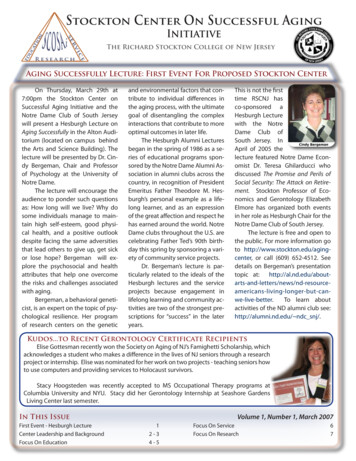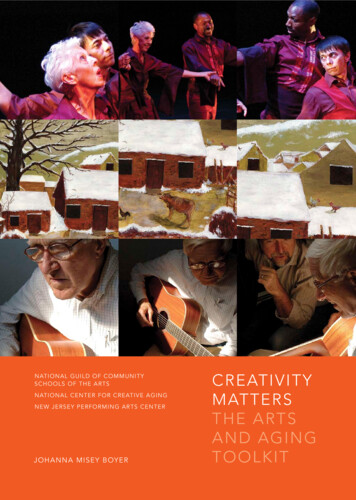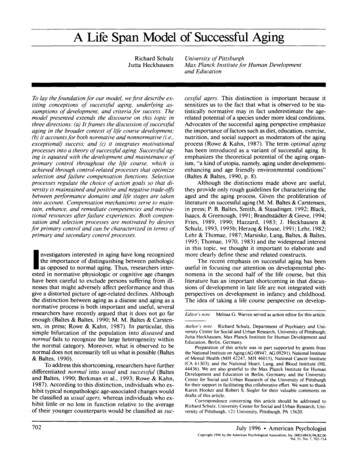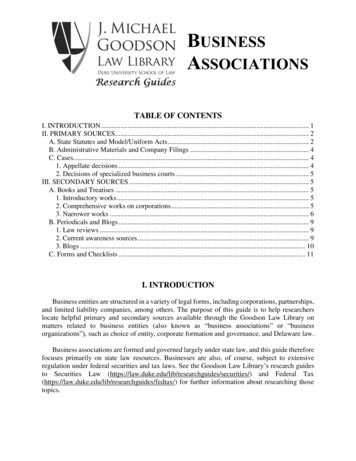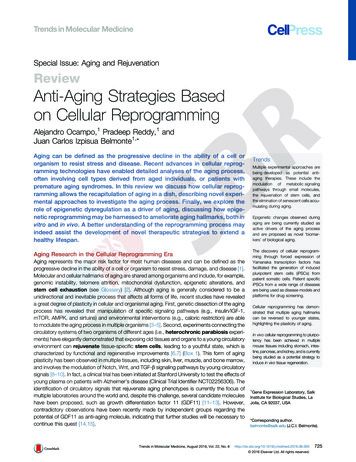
Transcription
PREDICTORS OF SUCCESSFUL AGING: ASSOCIATIONS BETWEEN SOCIALNETWORK PATTERNS, LIFE SATISFACTION, DEPRESSION,SUBJECTIVE HEALTH AND LEISURE TIME ACTIVITYFOR OLDER ADULTS IN INDIASwati Varshney, B.A., M.A.Dissertation Prepared for the Degree ofDOCTOR OF PHILOSOPHYUNIVERSITY OF NORTH TEXASAugust 2007APPROVED:Kimberly M. Kelly, Major ProfessorJ. R. Toledo, Committee MemberPaul Lambert, Committee MemberCarol Hagen, Committee MemberLinda Marshall, Chair of the Department ofPsychologySandra L. Terrell, Dean of the Robert B.Toulouse School of Graduate Studies
Varshney, Swati. Predictors of Successful Aging: Associations between SocialNetwork Patterns, Life Satisfaction, Depression, Subjective Health, and Leisure TimeActivity for Older Adults in India. Doctor of Philosophy (Health Psychology andBehavioral Medicine), August 2007, 49 pp., 3 tables, references, 90 titles.Aging in the new millennium is greatly influenced by both global and regionspecific factors. In Asia, the aged population is increasing at a faster rate than bothEurope and North America, making issues related to older adults needing immediateattention of researchers & planners. This study aims at identifying the predictors ofsuccessful aging. Successful aging as a construct often has an integration of goodsocial engagement, sense of purpose in life, maintaining cognitive capacity andfunctional autonomy. One hundred fifty participants in India completed the LifeSatisfaction Questionnaire, Geriatric Depression Scale, Health Awareness Schedule,and the Leisure Time Activity Record. Firstly, it is mainly evident that social supportnetwork is larger for older adults residing in a joint family as compared to a nuclearfamily setup. Further, married males in a joint family have the largest network sizecompared to all the other groups. The study however, reveals an interesting reversetrend of widowed females having a larger network size compared to widowed males.Statistical analysis found measures of successful aging to be highly correlated witheach other, with subjective health and depression being significant predictors of lifesatisfaction. Further, life satisfaction, depression levels, and leisure time activities wereall significant predictors of subjective health. Significant gender differences were foundon life satisfaction and subjective health with married males living in joint familiesreporting the highest scores on all the above measures. In addition, widowed women
showed the highest levels of depression, which relates to their lower life satisfaction,poor ratings of health and low involvement in leisure activities. The study achieved ahigher understanding of successful aging and presented a novel finding of educationallevel being significantly correlated with all measures of successful aging. This study isthe first of its kind to measure successful aging in an urban Asian-Indian population.However, more research is needed to examine other age-related variations to enablegeneralization of results to a larger culturally diverse population.
Copyright 2007bySwati Varshneyii
ACKNOWLEDGEMENTSAn undertaking such as a dissertation is not completed without the support ofmany people. My first debt of gratitude must go to my advisor, Dr. Kimberly Kelly. Shepatiently provided the vision, encouragement and advice necessary for me to proceedthrough the doctoral program and complete my dissertation. My committee membersdeserve a special note of praise, for they have watched over me since my first days asa graduate student. I wish to thank Dr. J.R. Toledo, Dr. Paul Lambert and Dr. CarolHagen for providing me with their support, guidance and helpful suggestions.This dissertation could not have been written without the support of Dr. N.K.Chadha at the University of Delhi, India. I wish to sincerely thank him for his advice,critique and guidance that he provided despite being overseas in India. I also thank himfor allowing me to use his measures for this research and providing numerous hours ofguidance during my data collection process in New Delhi, India. The examples of all myprofessors, as researchers and as teachers, continue to serve as guidelines for myacademic career.It has been a long journey and completing this work is definitely a high point inmy academic career. I could not have come this far without the assistance of myparents Madhu and Sumant Varshney and my brother Rahul. The love of family andfriends provided my inspiration and was my driving force to achieve all that I could inlife. I want to thank my husband, Jyothis for his love, encouragement and understandingin dealing with all the challenges I have faced in allowing me to finish this journey.iii
TABLE OF CONTENTSPageACKNOWLEDGEMENTS .iiiLIST OF TABLES .viChapterI.INTRODUCTION . 1Brief Overview of Aging and Related Concepts . 1Demographics of Aging. 1Theoretical Perspectives on Aging. 3Disengagement Theory . 4Activity Theory. 5Continuity Theory . 6Aging as an Exchange . 6Social Network Patterns. 6Life Satisfaction. 9Subjective Health and Well-being . 10Protection Motivation Theory. 11Health Belief Model . 11Physical Health and Aging . 12Dementia . 13Factors Determining Health Attitudes and Behaviors in the Elderly. 13Importance of Life Events. 13Subjective Health . 15Depression . 16Leisure Time Activity . 17Hypotheses . 19II.METHOD . 20Participants . 20Measures . 20iv
Life Satisfaction Scale . 20Geriatric Depression Scale (GDS). 21Mini Mental Status Examination (MMSE) . 23Health Awareness Schedule . 23Leisure Time Activity Record. 24Procedure . 25III.RESULTS . 26Descriptive Statistics . 26Post hoc Analysis. 27Correlational Analysis . 28Regression Prediction . 29Life Satisfaction . 29Subjective Health . 30IV.DISCUSSION . 32Overview of Aging . 32Importance of Social Network Patterns . 33Life Satisfaction and Successful Aging . 34Effects of Depression . 36Perceptions of Subjective Health . 36Involvement in Leisure Time Activities . 38REFERENCES. 43v
LIST OF TABLESPage1.Network Size (Means SD) for Male and Female Participants Living in Joint andNuclear Families. 402.Measures of Successful Aging (Means SD) for Male and Female ParticipantsLiving in Joint and Nuclear Families with Different Marital Status. 413.Correlational Analysis for Measures of Successful Aging. 42vi
CHAPTER IINTRODUCTIONBrief Overview of Aging and Related ConceptsDemographics of AgingAging is a multidimensional change involving the physical, psychological as wellas social aspects for an individual. It can be described as a progressive deterioration ofthe physical and mental functions resulting in a simultaneous decline in both thecapacity of the body to maintain homeostatic balance as well as the adaptability of theindividual to various stressors thereby consequently increasing the chances of illnessand mortality. However, not all individuals age in a similar way. In biological terms,aging is a dynamic process that represents the molecular, biochemical, physiologicaland structural changes that take place in an individual following the cessation of growth(Dey, 2003).The proportion of older adults is gradually increasing and the percentage of olderpeople in the world population is expected to increase rapidly from 9.5% in 1995 to20.7% in 2050 and further to 30.5% in 2150 (United Nations, 1998). In absolutenumbers, this would imply an increase from 542 million individuals in 1995 to 1.9 billionindividuals in 2050 and 3.3 billion older adults by 2150. Although, we know that theelderly population has been growing globally, what appears to be relatively new andsignificant is the rapid pace that this segment is increasing in the Asian region. In Asia,the aged population is increasing at a faster rate than both Europe and North America(Nayar, 2003). Thus, for Asian societies, the issues related to the elderly needimmediate attention of researchers, planners, and welfare agencies. China and India,1
Asia’s most populous nations, are estimated to contribute a significant proportion of thisgrowing number of older people (Irudaya-Rajan, Misra & Sarma, 2001).India had earned the distinction of being a ‘greying nation’ with about 7.7% of itspopulation consisting of older adults. Demographic projections estimate that more than176 million of Indian citizens will be in the age group of over 60 years of age,considered the geriatric age in the country. This would make it the second largestpopulation of the elderly in the world and 13% of India’s population by 2025 (Chadha,1997). Over the years, there has been a steady increase in the number of older adultsin India, especially women. The size of India’s elderly population aged 60 years isestimated to increase from 71 million individuals in 2001 to 179 million individuals in2031 and further to 301 million older adults by 2051. In addition, looking at thedemographic transitions within India, the pattern currently indicates that southern Indiahas the highest number of older adults over 60 years of age and will continue tomaintain this trend in the future. Central India with the second largest number of olderadults in 2001 is also projected to increase its population at the same pace as southernIndia by 2051, while lowest numbers are expected in northeast India (Christophe &Irudaya-Rajan, 1998).Aging in the new millennium will be greatly influenced by both global and regionspecific factors. The increasing numbers as well as significant changes in thesociocultural milieu are responsible for the recent emphasis on studies pertaining toolder adults in India. Even though the increasing numbers are attributable to thedemographic transition, a decline in the condition of the older population has been theresult of fast eroding traditional family system as well as a substantial increase in the2
migration of adult children from home. This has resulted in the caregiver issuebecoming a growing concern for national policy makers. The family as a single unit isundergoing changes leading to significant adjustments in accommodating and caring forolder adults in the family, making them more vulnerable to illness and psychosocialstrains in the absence of familial support network. In addition, these increasing numberswill result in a direct impact on the demand for health services in the country. Since theprimary health care system is not geared up for meeting the demands on this vast anumber, this will result in increasing the burden of care on both the individual and thefamilies of these older adults.Therefore, mobilizing additional resources for geriatric care as well as monitoringhealth behaviors will emerge as a major responsibility for health care professionals inIndia. However, challenges arising from growing old, especially in the area of behavioraland emotional health have not received much attention in the past. More informationand research is needed with regards to the determinants of quality of life, self-concept,well-being and health to further our understanding of life experiences in later years andtherefore provides a rationale for this study.Theoretical Perspectives on AgingDespite the tremendous interest in aging, the concept remains poorly understoodyet excessively theorized. Psycho-social theories however, help in identifying thedegree and the nature of psycho-social factors associated with change across the adultlife course as well as measures the extent frustration and contentment of these changeagents at various stages of the life cycle of the individual.3
Disengagement theory. Disengagement theory was one of the earliest theoriesproposed in social gerontology and focused on adjustments to role change among theelderly, postulating that role loss led to maladjustments for the individual. Cummingsand Henry (1961) refer to the aging process as “an inevitable mutual withdrawal ordisengagement resulting in decreased interaction between the aging individual and theothers members of his social system”. They further state that this disengagement fromsocial interactions that occurs in old age is a universal process. Thus, disengagementimplies a loss of roles, restriction of social contacts and relationships, reducedcommitment to social values as well as reduction in activity levels and involvementcausing a loss of morale.The Indian version of this theory is known as the ‘Ashrama theory’ or the notionof the four-stage ideal life course (Bhatia, 1983). This cultural version emphasizes thetraditional Hindu view of life and delineates four ‘Ashrams’ or distinct stages or phasesof human life and development. The first stage that every individual goes through is the‘Brahmcharya’ stage, which is a stage of learning skills and receiving an education andlasts roughly for the first 25 years of life. This stage is followed by the ‘Grihasthashram’,roughly coinciding with the domestic phase involving performing the duties of ahouseholder as well as raising and maintaining a family, lasting from age 26 to age 50.‘Vanaprastha’ represents a stage of gradual withdrawal, without reducingresponsibilities and is roughly between 51 and 75 years. The last stage, ‘Sanyasa’, isone of total renunciation of all attachments and submission of oneself to the pursuit ofspiritual freedom. Essentially this stage represents retirement from the mundane and4
routine activities of life. The third and fourth stages are often combined to represent thepresent retirement phase of over 65 years.These stages are not rigid or mandatory or even obligatory on the part of anyindividual, but they have been suggested as a means of ensuring a smoother transitionin life and are well known and accepted by the members of the society. This theoryhowever, views social disengagement with regards to age stratification, age based rolesand social sanctions. This theory however has been criticized since the amount ofdisengagement or involvement is now seen more as a function of past life patterns andsocioeconomic factors rather than being an inherent process (Palmore, 1969).Activity theory. Activity theory (Havinghurst, 1953) was developed in directopposition to the disengagement theory to primarily define the concept of successfulaging. It emphasizes that normal and successful aging involves preserving the attitudesand activities of middle age for as long as possible, thereby keeping the older adultpsychologically, behaviorally and socially fit. In addition, it also views the relationshipbetween the society and the aging individual as stable. Research has also repeatedlyfound a positive association between morale, personal adjustment and activity levels ofolder adults (Palmore, 1979).Activity theory postulates that the greater the role loss for the individual, thelesser is his participation in various activities. However, if the level of activity remainshigh, the availability and stability of role identity is also high resulting in an improvedself-concept and life-satisfaction. Activity theory has however been criticized foroversimplifying the concepts and does not provide an adequate explanation for theinterests and abilities surrendered by older people as they cross middle age.5
Continuity theory. Continuity theory views various stages of the life cycle asbeing characterized by a high degree of continuity. It starts with the single notion thatthe individual tries to maintain his/her lifestyle for as long as possible and then adjustsand adapts to situations based on his/her perception of their changing status. Thedecision regarding the roles to be discarded or maintained is largely determined by theindividual’s past history and preferred style of life (Neugarten, 1968). Even though thecontinuity theory has the advantage of offering a multiplicity of adjustment patterns,there have been difficulties in empirically testing this theory.Aging as an exchange. The exchange theory (Dowd, 1975) provides a linkbetween an individual’s personal resources and the nature of their social interaction.According to this theory, people enter into social relationships to derive rewards likerecognition, security, love, etc. and in the process also incur costs like unpleasantexperiences and fatigue. Power is usually derived from imbalances in social exchange,with maximizing rewards and minimizing costs. In the case of the elderly, there is oftendeterioration in their bargaining position and decreasing power resources, resulting inincreasing their vulnerability to a multitude of psycho-social factors.Thus, there are a number of factors that influence the aging process. Thesevaried perspectives provide alternative explanations of the aging process and add to ourunderstanding of the multiplicity of directions for future research.Social Network PatternsA variety of aspects of social engagement and social network such as duration,quality of linkages, and identity of the individual in the network have been effectivelyexamined in understanding the aging process. Research indicates that the maintenance6
of robust social networks becomes an important factor in prediction of satisfaction withlife, activity levels as well as adequate mental health of individuals as they age (VanWilligen, Chadha & Kedia, 1995). The aged in Asian traditions have always occupied aposition of respect to the point of reverence. Respect for age is a deeply embeddedcultural value, and possibly derives its strength from the ancient religious texts from theIndian subcontinent.Traditionally, the informal support systems of family, kinship and community areconsidered strong sources of providing support to the older adults in the society in India.Older adults typically enjoy an “ascribed” status providing them with authority, wisdom,maturity, prestige and power in the society. In general, in Asian societies, the elderlyremain integrated with the family and the community. The older people in urban areas toa large extent still enjoy a fairly high status in their families and are generally wellrespected by their children. Desai and Naik (1971) report that in the advice of the elderlyis usually taken in all family affairs. In addition, recent studies indicate that theattachment between children and their parents as well as the commitment to care of theelderly is an essential element in Indian culture (Ramamurthi & Jamuna, 1993). Thisincludes providing emotional, financial as well as socio-cultural support and assistancein varying degrees.Gender clearly influences the type and the amount of care received for a person.Women care-givers provide typically provide personal care, housekeeping tasks andmeal preparation, male care-givers provide assistance with home-repairs, transportationand financial management (Bali, 2003). In addition, the size and the composition of thesupport network influences the organization and provision of care. Larger networks of7
caregivers often result in sharing of responsibilities. Srivastava (1988) reported that66% of Delhi’s population lives in a joint family setting and about 33% population lives innuclear families, with over 60% individuals living in households with five or moremembers. An Indian joint family typically consists of an older married couple, their sonsand daughter-in-laws, unmarried daughters and sons’ children. The presence of at leasttwo married couples residing in the same house is the distinguishing feature of jointfamilies. The joint family is both a collective as well as a set of individuals. A number offactors mediate family exchange and can be classified into family structure,interpersonal relationships and personal circumstances. Research indicates that a jointfamily system provides an important mechanism for the social support of older adults(Kolenda, 1987).However, with the dynamic and rapid socio-cultural changes, several structuralchanges are taking place in the traditional Indian society. The pressure on the traditionalmethods of caring for older family members is expected to increase partly driven byurbanization. As a result, changes in kinship networks, living arrangements and intergenerational dynamics are likely to increase at a faster rate in urban areas of India.Members of joint families are living geographically apart and family structures areincreasingly becoming smaller and more independent. The “ascribed” status of the olderpopulation is gradually being replaced by the “achieved” status of the youngerpopulation resulting in drastic changes in family structure, social norms and anincreased psycho-social strain especially in the urban areas for the former section of thepopulation. The changing social environment has affected the family structures,individual lifestyles as well as the role of the family as a care-giver influencing the self-8
concept, incidences of depression, loneliness and involvement in the community for theelderly in India.Life SatisfactionA feeling of satisfaction with life is an important factor for a general sense of wellbeing (Neugarten 1982) and has been emphasized in research related to subjective wellbeing. Life satisfaction often refers to the attitudes that individuals have about their past,present as well as future in relation to their psychological well being (Chadha & VanWilligen, 1995). Research has indicated that the concept of high life satisfaction can beequated to that of successful aging (Jamuna, 1994; Husain & Singh, 1995). Themeaning of successful aging is elusive and can be highly susceptible to one’s ownsocial value or judgments about the important aspects of life. However, this conceptwith regards to life satisfaction has psychological as well as social implications. Firstly, itimplies the personal contentment with life and positive self-regard for an individual andsecondly it includes a personal appraisal of fulfilling one’s social roles or obligations.Successful aging includes three components: low probability of disease and diseaserelated disability, high cognitive and physical functional capacity and active engagementwith life (Rowe & Kahn, 1997). Vita, Terry and Huber et., al (1998) also report that inrecent years, a greater percentage of older adults appear to be living up to this modeland succeeding at living independently and without disabilities.Life satisfaction among the elderly is an important concept as it gives us anoverall view of the adjustment as well as adaptive coping ability of the individual.Sarkisian, Hays and Mangione (2002) further found in their study that individuals withlower life satisfaction and lower expectations about aging typically do not perceive it as9
important to seek health care for age-associated conditions and therefore experiencehigher levels of depression, have less energy and poor health-related quality of life. Thelevel of satisfaction among the aged effects not only their psychological adjustment butalso physical, emotional and social well-being. Therefore, social support network,perceived health and leisure time activity may be associated with life satisfaction.Subjective Health and Well-beingSubjective well-being is a rapidly growing area both in research and appliedfields of psychology. The concept is important for understanding the well-being of anindividual with regards to cognitive and affective reactions to their life along with specificdomains of life. Subjective well-being consists of three interrelated components of lifesatisfaction, pleasant affect and depression (Diener & Suh, 1997). High feeling of wellbeing and life satisfaction also has a direct impact on domains of life such as work andleisure time activity.The elderly invariably suffer from diseases of the respiratory system; symptomsof ill-defined arthritis and rheumatism, hypertension, congestive heart failure anddiabetes and many people often consider illness among older adults to be a symptom ofaging (Nayar, 1996). However, self-rated health or the perception of an individual aboutone’s health has a definite effect on one’s well being. Maintenance of health in old ageis linked with health beliefs, attitude and practice of positive health behaviors amongindividuals (Reddy & Ramamurti, 1996). Various theoretical perspectives have alsosupported perception of health associated with the nature of coping as well as engagingin positive health behavior by the individual.10
Protection Motivation Theory. This theory postulated by Maddux and Rogers(1983) is partially based on the work of Lazarus and Leventhal. It describes adaptiveand maladaptive coping with a health threat primarily as a consequence of twoappraisal processes. These include a process of threat appraisal and a process ofcoping appraisal, in which the behavioral options to diminish the threat are evaluated.Thus, individuals who perceive themselves as elderly are significantly more maladjustedcompared to other cohorts (Boer & Seydel, 1996). The appraisal of the health threat andthe appraisal of the coping responses result in the intention to perform adaptiveresponses (protection motivation) or may lead to maladaptive responses, which placesan individual at health risk.Health Belief Model. Perceived health can also be understood in relation to theHealth Belief Model, where it can be defined as any medically recommended action,voluntarily taken by the individual who believes himself/herself to be healthy and takesaction to prevent as well as detect disease in an asymptomatic stage (Langley, 1977).The Health Belief Model offers one of the most influential explanations for the reasonthat people engage in certain health behaviors (Rosenstock, 1966,1974).This model suggests that an individual’s decision to perform a health behavior isinfluenced by a wish to avoid becoming ill and a belief that a specific health action willprevent or reduce the illness. The model also specifies two basic types of beliefs, whichare hypothesized to motivate individuals to engage in particular preventive behaviors.These are perceived vulnerability to and the perceived seriousness of theconsequences of incurring a disease, which then heightens the ‘psychological state ofreadiness’ to take specific action. Given the high state of readiness, the direction of the11
action taken by the individual depends upon their beliefs about relative effectivenessand availability of alternative actions known to the individual (Rosenstock, 1966, 1999).Kergels (1969) has introduced the concept of “saliency” of health as being animportant modifier of the Health Belief Model. He suggests that the motivation toengage in preventive health behaviors may be operative only for those who view theirhealth as salient or having a high priority when compared to other activities in life.Although a few studies have completely supported the model, a vast majority orresearch has found only partial support for the model.In order to better understand healt
PREDICTORS OF SUCCESSFUL AGING: ASSOCIATIONS BETWEEN SOCIAL NETWORK PATTERNS, LIFE SATISFACTION, DEPRESSION, . Doctor of Philosophy (Health Psychology and Behavioral Medicine), August 2007, 49 pp., 3 tables, references, 90 titles. . on life satisfaction and subjective health with married males
